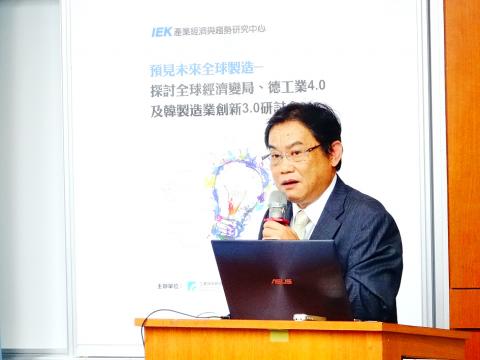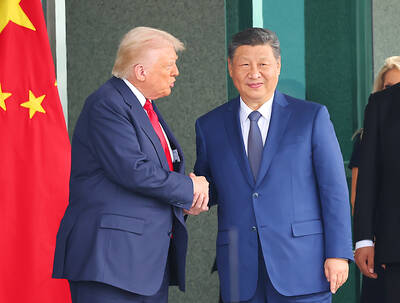The manufacturing sector is expected to return to growth only from next quarter, as a stagnant global economy and intensifying competition continue to stifle demand, the Industrial Economics and Knowledge Center (IEK) said yesterday.
IEK originally expected the manufacturing sector to recover from a recession this quarter.
Now, the Hsinchu-based market researcher expects the sector to see revenue shrink by 0.48 percent this quarter, before picking up and posting an annual growth of 0.87 percent next quarter.

Photo: Wang Meng-lun, Taipei Times
For the whole of this year, IEK forecasts sector revenue growth of 0.11 percent to NT$17.79 trillion (US$550.26 billion), down from the 0.96 percent increase to NT$17.94 trillion it estimated three months ago.
“We are conservative about the sector’s outlook this year as the global economic situation remains unclear,” IEK senior researcher Peter Cheng (陳志強) told a media briefing in Taipei, adding that some of the positive signs seen in the first quarter did not materialize.
As Iran is resuming crude oil production after years-long sanction, global crude oil prices only rebounded to about US$40 per barrel rather than US$50, capping IEK’s forecast revenue growth for the nation’s petrochemical industry at an annual pace of 2.57 percent, instead of the 3 percent it estimated previously, Cheng said.
The information and communication industry, the pillar of the nation’s manufacturing sector, is expected to expand at a slower annual rate of 1.34 percent to NT$6.33 trillion, compared with the previous forecast of 2.16 percent annual growth.
“Demand is depressed by weaker-than-expected sales of high-end smartphones as indicated by the soft demand for iPhones. Growth has also decelerated in emerging nations due to market saturation,” Cheng said.
He said that lackluster demand for LCD panels is dragging down the information and communication segment’s growth.
However, the semiconductor segment would see an annual growth rate of between 2.1 percent and 3.3 percent this year to about NT$2.3 trillion, IEK forecast.
“The nation’s semiconductor industry has shown signs of a gradual recovery, backed by improving US consumer confidence and rising electronics orders from China,” IEK semiconductor analyst Jerry Peng (彭茂榮) said.
Despite the anticipated recovery, Taiwan Semiconductor Industry Association (台灣半導體協會) director-general Nicky Lu (盧超群) said Taiwan still faces growing challenges amid escalating competition and a talent shortage.
“MediaTek Inc (聯發科) and local chip testers and packagers are facing challenges to cope with growing competition as China is injecting more state funds, totaling more than NT$600 billion, to foster its [semiconductor industry],” Lu said.
Lu, who is chairman of chip designer Etron Technology Inc (鈺創), said Taiwanese companies are also facing a talent shortage. He blamed the problem on the abolition of the stock bonus mechanism and the income tax levy on year-end bonuses for technology employees.
Lu called on the government to amend the Company Act (公司法) by allowing companies to determine the face value of their shares, instead of mandatorily setting it at NT$10 per common share.
For greater financial flexibility, startup companies should be allowed to issue two types of stocks — common shares for company founders and preferred shares for investors — at different face value, Lu said.
This is a practice that has been adopted in the US and most countries around the world, he said.
To encourage the development of startups, common shares usually carry a much higher face value than preferred shares, he said.

RUN IT BACK: A succesful first project working with hyperscalers to design chips encouraged MediaTek to start a second project, aiming to hit stride in 2028 MediaTek Inc (聯發科), the world’s biggest smartphone chip supplier, yesterday said it is engaging a second hyperscaler to help design artificial intelligence (AI) accelerators used in data centers following a similar project expected to generate revenue streams soon. The first AI accelerator project is to bring in US$1 billion revenue next year and several billion US dollars more in 2027, MediaTek chief executive officer Rick Tsai (蔡力行) told a virtual investor conference yesterday. The second AI accelerator project is expected to contribute to revenue beginning in 2028, Tsai said. MediaTek yesterday raised its revenue forecast for the global AI accelerator used

Taiwan Semiconductor Manufacturing Co (TSMC, 台積電) has secured three construction permits for its plan to build a state-of-the-art A14 wafer fab in Taichung, and is likely to start construction soon, the Central Taiwan Science Park Bureau said yesterday. Speaking with CNA, Wang Chun-chieh (王俊傑), deputy director general of the science park bureau, said the world’s largest contract chipmaker has received three construction permits — one to build a fab to roll out sophisticated chips, another to build a central utility plant to provide water and electricity for the facility and the other to build three office buildings. With the three permits, TSMC

TEMPORARY TRUCE: China has made concessions to ease rare earth trade controls, among others, while Washington holds fire on a 100% tariff on all Chinese goods China is effectively suspending implementation of additional export controls on rare earth metals and terminating investigations targeting US companies in the semiconductor supply chain, the White House announced. The White House on Saturday issued a fact sheet outlining some details of the trade pact agreed to earlier in the week by US President Donald Trump and Chinese President Xi Jinping (習近平) that aimed to ease tensions between the world’s two largest economies. Under the deal, China is to issue general licenses valid for exports of rare earths, gallium, germanium, antimony and graphite “for the benefit of US end users and their suppliers

Dutch chipmaker Nexperia BV’s China unit yesterday said that it had established sufficient inventories of finished goods and works-in-progress, and that its supply chain remained secure and stable after its parent halted wafer supplies. The Dutch company suspended supplies of wafers to its Chinese assembly plant a week ago, calling it “a direct consequence of the local management’s recent failure to comply with the agreed contractual payment terms,” Reuters reported on Friday last week. Its China unit called Nexperia’s suspension “unilateral” and “extremely irresponsible,” adding that the Dutch parent’s claim about contractual payment was “misleading and highly deceptive,” according to a statement